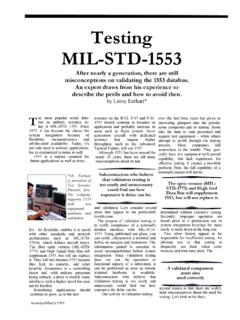Transcription of 30 - davi.ws
1 2001 by CRC Press LLC 30 New avionics Systems Airbus A330/A340 Overvie w Highlights Systems Cockpit User Involvement avionics Instruments Navigation Flying Controls Central Maintenance System Communications Flexibility and In-Service Updates Development Environment Support Environment Overview The A330/A340 project is a twin programme the first time that an aircraft has been designed fromthe outset both with four engines, and also with two engines. Both aircraft types have essentially thesame passenger and freight capacity. The four-engined A340 is optimized for long-range missions, butis also efficient at shorter ranges. With two engines, the A330 offers even better operating economics forthe missions where an airline does not need the very long range of the realization that on the two different aircraft very many features could in fact be engineered thesame way without a penalty, was the key to obtaining substantial commonality between the two approach has provided very substantial advantages for the operators, the airframe manufacturer,and for the equipment vendors.
2 In effect, by designing for both sister aircraft from the outset, therequirements were engineered in common, and any added features for either of the two aircraft couldbe introduced at a point in the design where they cost very little extra in terms of price, weight,reliability/maintainability or fuel a result, the two aircraft use the same parts (except the engine-related parts), can use the sameaircrews, use the same airport and maintenance environment, and cost almost the same to develop as asingle aircraft. And both are supremely A340 is offered in two configurations, allowing operators to tailor capacity and capability todemand. The larger A340-300 has the same fuselage length as the A330 and, while seating 300 to350 passengers, has seat-mile costs close to those of the latest 747, making it an economical alternativeon long-range routes with lower traffic densities.
3 Potocki de Montalk Airbus Industrie 2001 by CRC Press LLC The A340-200, seating 250 to 300 passengers, has the longest range capability of any commercialairliner available. Its low trip costs, coupled with the operating flexibility of four engines, make it anideal aircraft for taking over when long-range twins become the A340 serves very long routles, the A330 is designed to serve high-growth, high-densityregional routes. At the same time, it has the capability to operate economically on extended-rangeinternational routes. With typically 335 seats in a two-class arrangement, the A330 has a range of 4500nmi with a full complement of passengers and baggage and 3200 nmi with maximum payload, makingit ideal as a direct replacement for the costlier trijets and as a growth replacement for earlier twinjets.
4 Highlights The A330 and A340 are built on the technological background established by two previous, complemen-tary, product A300/A310 series is the world s best-established twin-jet twin-aisle aircraft programme, with avery large number of technologically advanced features that transfer to larger, longer-range A319/A320/A321 series is the world s most advanced single-aisle aircraft programme, again offer-ing a large number of features that are found on much larger the entire development process, there has been an insistence on securing the maximumcommonality that could be achieved with the other programmes without loss of efficiency. Using selectedfeatures from each of these product lines, updated as needed, resulted in an all-new A330/A340 aircraftprogramme remarkably free of teething troubles, while at the same time providing a new benchmark foraircraft in this size category.
5 As an added benefit, the technological features of the A330/A340 can, inmany cases, be used to improve the established older product lines. Systems Before the entry into service of the A330/A340, the world s most technologically advanced airliner, inany category, was the A320. Its design formed the basis for the A330/A340 systems. Cockpit The A330/A340 cockpit is designed to be identical to that of the A320, from the point of view of thecrew. The exceptions to this rule are associated with the size of the aircraft and to the added needs ofthe long-range mission, such as improved dispatchability, polar navigation capability, and of course,engine-related result is that the 130-seat-capacity short/medium haul A319 up to the 340-plus seat capacity verylong-haul A340 have the most advanced flight deck of any airliner, enabling the same crews to fly any ofthese aircraft with minimum additional training needed.
6 User Involvement The design of the A330/A340 cockpit has evolved from the same methods that were used successfully onthe first Airbus Industrie initial design of the cockpit (and the systems) was based on three features: The existing cockpit from the previous aircraft (the A320 in this case). The geometry of the A330/A340 nose section (which is based on the geometry of the A300, A310,and 300-600). Applicable new research and development work carried out since the A320 had been designed. 2001 by CRC Press LLC This initial design was reviewed by a task force consisting of pilots and engineers of each of the launchairlines in the light of their experience with the A320 or with other aircraft that were operating on theintended routes for the A330 and task force met a number of times over a period of over a year.
7 At each of these steps the designof the A330/A340 was refined, and certain features were mocked up for the next iteration in the final design of the aircraft system and cockpit is essentially the one that the airline task forceexperienced and flew in the simulators during their final sessions. avionics The avionics of the A330/A340 are highly integrated for optimal crew use and for optimal with all previous new and derivative aircraft since the A300FF of 1981, the primary data bus standardis ARINC 429 with ARINC 600 packaging. Other industry bus standards are used in specific applicationswhere ARINC 429 is not suitable. Instruments The six CRTs on the main instrument panel display present flight and systems information to the arrangement provides excellent visibility of all CRTs.
8 Flight information is provided by the Electronic Flight Instrumentation System (EFIS) consisting ofa PFD and a ND in front of each information is provided by the Electronic Centralized Aircraft Monitor (ECAM) consistingof the engine/warning display on the upper screen and aircraft systems display on the lower throughout the aircraft continuously monitor the systems and if a parameter moves out ofthe normal range they automatically warn the normal flight the ECAM presents systems displays according to the phase of flight, showingthe systems in which the pilot is interested, , some secondary engine data, pressurization, and cabintemperature. The pilot can, by manual selection, interrogate any system at any time. Should anothersystem require attention, the ECAM will automatically present it to the flight crew for a system fault occur that results in a cascade of other system faults, ECAM identifies theoriginating fault, and presents the operational checklists without any need for added crew information display formats currently in use enable the pilots to assimilate the operationalsituation of the aircraft much more easily than on the previous generation of are substantial advantages on the maintenance side as well, in that the entire Electronic Instrumentsystem consists of only three LRU types, enabling significant dispatchability and spare stocks fact, all the flight information (including standby)
9 Is presented on only 11 instruments of 6 new EIS, using liquid crystal displays, is being installed on the A330/A340 and A320 family of aircraftdeliverable from 2001, offering improved capabilities and cost of ownership. Navigation Dual Flight Management Systems (integrated with the Flight Guidance and Flight Envelope computingfunctions; FMS) combine the data from the aircraft navigation sensors, including the optional GPSinstallation. Backup navigation facilities are included in each pilot s MCDU, allowing the aircraft to bedispatched with an inoperative FMS permits the crew to select an optimal flight plan for their route from a selection in the airlinenavigation data base, allowing the aircraft to fly automatically, through the autopilot or flight director,from just after take-off until the crew elects to carry out a precision approach and automatic canned flight plan captures the data needed for flight from the specifications entered by the crewprior to departure, as well as along the route as conditions change and more current information onweather and routing becomes available.
10 2001 by CRC Press LLC New FMSs, with improved cost of ownership and capability, are being installed on aircraft deliveredfrom mid-2000. The same new FMSs are being installed on the A320 family. Flight Controls The flight control system of the A330/A340 is essentially the same as that of the A320, with five computersof two different types allowing the pilot to control the aircraft in pitch, roll, and yaw. The layout of the pilotcontrols is essentially the same as that of the A320 series, as are the handling qualities of the A330/A340. Thetechnology features are also essentially the same, with extensive use of dissimilarity in the hardware and inthe software, and extensive segregation in the hydraulic and electrical power supplies and signalling lanes. Aswith the A320 series, mechanical signalling is used for the rudder and for the horizontal stabilizer trim changes have been introduced reflecting the longer mission times, specially of the A340, toprovide better access to the system, and the opportunity has been taken to reduce the variety of backupsubmodes that the crew must use, making the aircraft even easier to the A320 series, the A330/A340 is a conventional, naturally stable airliner.

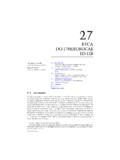

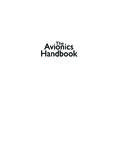
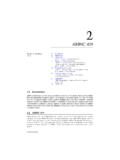
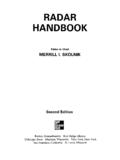


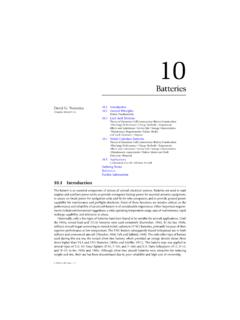

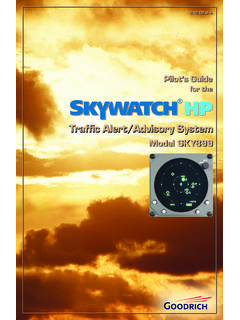
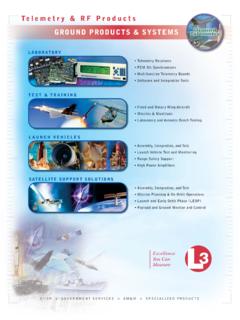

![Dlink+ w/CPDLC Technical Description 14114 1 [XX]](/cache/preview/a/b/b/7/c/9/4/6/thumb-abb7c9465faae86b705dab4701ef1533.jpg)
